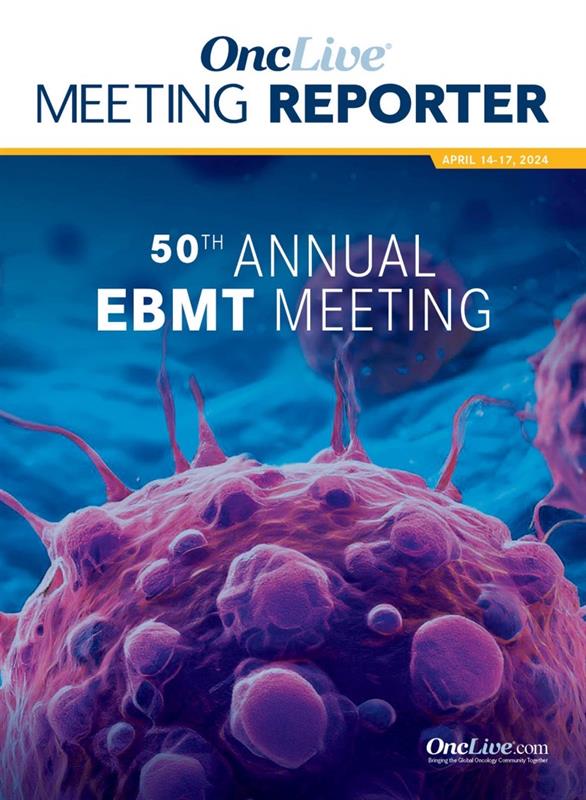News
Article
Supplements and Featured Publications
Orca-T May Be a Suitable Option Over PTCy-Based HSCT in Acute Leukemia and MDS
Author(s):
Orca-T demonstrated positive impacts on relapse-free survival and overall survival vs PTCy-based HSCT in acute leukemias and myelodysplastic syndrome.
Amandeep Salhotra, MD

The high-precision cell therapy Orca-T plus tacrolimus may improve outcomes compared with post-transplant cyclophosphamide (PTCy)-based myeloablative conditioning (MAC) peripheral blood stem cells (PBSC) hematopoietic stem cell transplantation (HSCT) in patients with acute leukemia or myelodysplastic syndrome (MDS), according to data from a retrospective analysis presented during the 50th Annual EBMT Meeting.
Data from the retrospective analysis showed that the 1-year relapse-free survival (RFS) rates were 77% for patients who received Orca-T vs 62% for those treated with PTCy (HR, 0.5; 95% CI, 0.3-0.9); 1-year non-relapse mortality (NRM) rates were 0% vs 17%, respectively. Additionally, patients who received Orca-T achieved a 1-year overall survival (OS) rate of 94% whereas patients who received PTCy experienced a 1-year OS rate of 77% (HR, 0.2; 95% CI, 0.1-0.6).
“The positive impact on RFS, NRM, and OS, in addition to reduced graft-versus-host disease [GVHD] seen with Orca-T highlight the importance of identifying treatment approaches that may be beneficial across all key transplant outcomes,” Amandeep Salhotra, MD, a hematologist-oncologist as well as an associate professor in the Division of Leukemia, Department of Hematology and Hematopoietic Cell Transplantation, at City of Hope in Duarte, California, and coauthors, wrote in a poster presentation of the data.
Additionally, patients in the acute myeloid leukemia (AML)/MDS cohort achieved a 1-year RFS rate of 86% in the Orca-T group vs 63% in the PTCy group (HR, 0.3; 95% CI, 0.1-0.8); the 1-year NRM rates were 0% vs 17%, respectively. The 1-year OS rates were 100% vs 76%, respectively. Further, an analysis of the myeloid subgroup revealed that age impacted NRM rates for patients treated with PTCy; the 1-year NRM rate was 8.5% for patients 55 years or less and 24.0% for those over 55 years. In the Orca-T group, 1-year NRM rates were 0% irrespective of age.
“Identifying an allogeneic HSCT modality that can reduce GVHD, lower NRM, and increase RFS is key to improving outcomes for patients with hematologic malignancies. Recently, the [use] of PTCy as prophylaxis against GVHD has increased; however, PTCy-based HSCTs after MAC may be associated with higher toxicities requiring prolonged hospitalization, NRM, and relapse at 1 year,” study authors explained.
The study included data obtained from the Center for International Blood and Marrow Transplant Research on patients who underwent transplantation from 2011 to 2018. Patients over the age of 18 who had GVHD prophylaxis with PTCy and calcineurin inhibitor/mycophenolate mofetil, and MDS or AML/acute lymphoblastic leukemia (ALL) in first or second complete response were included in the analysis. Additionally, matched unrelated donors who were treated with myeloablative conditioning and a GCSF-mobilized PBSC allograft between 2015 and 2018 were included.
Patients who comprised the Orca-T arm of the analysis were over 18 years of age with MDS, AML, ALL, or mixed-phenotype acute leukemia in CR/CRi; they received Orca-T between 2019 and 2022 as part of a multicenter phase 1b single-arm trial (NCT04013685) and had an 8/8 matched unrelated donor or matched related donor.
Orca-T treatment was comprised of MAC with single-agent prophylaxis using tacrolimus from day -10 to -2 followed by HSPC Tregs and Tcons and the post-transplant period. The HSPC Tregs infusion was administered on day 0 at a cell dose of 3e6 Treg/kg and vein to vein time was less than 72 hours; Tcons were given via infusion on day 2 at a cell dose of 3e6 Tcells/kg. Tacrolimus monotherapy was then administered on day 3 at a target dose of 5 to 10 ng/mL. Study authors noted that methotrexate, PTCy, or additional immunosuppressive therapies were not given with Orca-T.
Patients included in the study who received T-cell replete graft plus PTCy/CNI/MMD (n = 83) were a median age of 52 years (range, 18-71) compared with 49 years (range, 20-65) for those in the Orca-T and tacrolimus arm (n = 111). Most patients in both arms were male (51% vs 53%), all received MAC, and the median follow-up time was 12 months vs 17 months, respectively. Primary disease sites consisted of ALL (26.5% vs 33.3%), AML (49.4% vs 45.9%), MDS (24.1% vs 15.3%), chronic myeloid leukemia (0.0% vs 3.6%), and mixed-phenotype leukemia (0.0% vs 1.8%) in the PTCy vs Orca-T groups. Additionally, all patients in the PTCy arm had an unrelated donor compared with 49.5% in the Orca-T arm.
Furthermore, in the AML/MDS cohorts, the median age among patients who received T-cell replete graft plus PTCy/CNI/MMD (n = 61) was 57 years (range, 20-71) compared with 54 years (range, 20-64) for those in the Orca-T and tacrolimus arm (n = 48). Patients had AML (67.2% vs 77.1%) or MDS (32.8% vs 22.9%), most patients in both arms were male (51% vs 52%), and all received MAC, respectively. Additionally, all donors were unrelated in the PTCy arm vs 42% in the Orca-T arm.
Study authors noted that longer-term data will aid in determining the differences in clinical outcomes and a randomized phase 3 trial (NCT05316701) evaluating Orca-T vs. standard allogeneic HSCT is currently ongoing.
Reference
Salhotra A, Arteaga AG, Oliai C, et al. A retrospective analysis comparing ORCA-T to post-transplant cyclophosphamide based allogeneic hematopoietic stem cell transplant in patients with matched unrelated donors receiving myeloablative conditioning. Presented at: EBMT 50th Annual Meeting; April 14-17, 2024. Abstract A107.










